College & Career Readiness
Research References
Click bullet to access abstract and full citation.
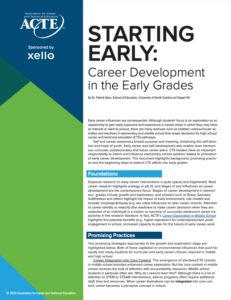 Early career influences are consequential. Career exploration in the early grades exposes students to varied pathways. Hobbies, extracurricular activities and electives in elementary and middle school shape career and technical education (CTE) pathways. In this brief by the Association for Career & Technical Education (sponsored by Xello), Dr. Patrick Akos (School of Education, University of North Carolina at Chapel Hill) offers promising strategies to help educators ready students for curricular and early career choices.
Early career influences are consequential. Career exploration in the early grades exposes students to varied pathways. Hobbies, extracurricular activities and electives in elementary and middle school shape career and technical education (CTE) pathways. In this brief by the Association for Career & Technical Education (sponsored by Xello), Dr. Patrick Akos (School of Education, University of North Carolina at Chapel Hill) offers promising strategies to help educators ready students for curricular and early career choices.
Akos, P. (2020). Starting Early: Career Development in the Early Grades (Rep.). Alexandria, VA: Association for Career & Technical Education.
Retrieved from Xello_Starting-Early-Publication_FINAL.pdf (acteonline.org)
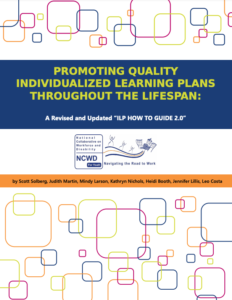 Promoting Quality Individualized Learning Plans throughout the Lifespan: A Revised and Updated ILP How to Guide 2.0 expands upon the guidance and resources in NCWD/Youth’s earlier ILP How to Guide. ILP How to Guide 2.0 provides career development resources and examples of ILP implementation for an expanded range of age groups and settings including elementary and secondary school, postsecondary education, workforce development programs and other non-school settings. It also offers strategies for building and supporting capacity at the local level to facilitate adoption of the ILP process and provides examples of how to ensure that ILPs are implemented with quality.
Promoting Quality Individualized Learning Plans throughout the Lifespan: A Revised and Updated ILP How to Guide 2.0 expands upon the guidance and resources in NCWD/Youth’s earlier ILP How to Guide. ILP How to Guide 2.0 provides career development resources and examples of ILP implementation for an expanded range of age groups and settings including elementary and secondary school, postsecondary education, workforce development programs and other non-school settings. It also offers strategies for building and supporting capacity at the local level to facilitate adoption of the ILP process and provides examples of how to ensure that ILPs are implemented with quality.
Solberg, S., Martin, J., Larson, M., Nichols, K., Booth, H., Lillis, J., & Costa, L. (2018, March 19). Promoting Quality Individualized Learning Plans throughout the Lifespan: A Revised and Updated ILP How to Guide 2.0.
Retrieved from
http://www.ncwd-youth.info/wp-content/uploads/2018/03/Promoting-Quality-ILPs-Throughout-the-Lifespan-WEB.pdf
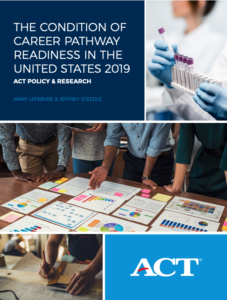 This report highlights the levels of career pathway readiness for various groups of ACT WorkKeys examinees in the US and provides career pathway readiness benchmarks for foundational skills by career cluster. It looks at the progress of the ACT®-tested 2019 U.S. high school graduating class relative to college and career readiness. Specifically, the report includes data tables broken out for all 16 Career Technical Education Career Clusters. More than numbers and figures, the report offers some method behind the madness of trying to figure out what different types of career readiness could mean for different individuals and use cases.
This report highlights the levels of career pathway readiness for various groups of ACT WorkKeys examinees in the US and provides career pathway readiness benchmarks for foundational skills by career cluster. It looks at the progress of the ACT®-tested 2019 U.S. high school graduating class relative to college and career readiness. Specifically, the report includes data tables broken out for all 16 Career Technical Education Career Clusters. More than numbers and figures, the report offers some method behind the madness of trying to figure out what different types of career readiness could mean for different individuals and use cases.
Lefebvre, M., & Steedle, J. (2019). The Condition of Career Pathway Readiness in the United States 2019 Policy & Research.
Retrieved from
http://www.act.org/content/act/en/research/reports/act-publications/condition-of-career-pathway-readiness.html
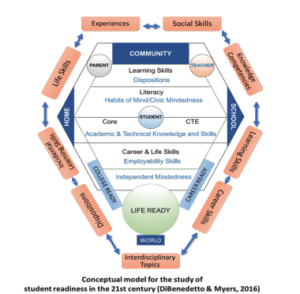 Awareness of one’s knowledge, skills, and dispositions are important for college graduates to excel in the workforce. A needs assessment administered to students enrolled in the Agricultural Sciences department at Clemson University revealed career skills, interdisciplinary skills, life skills, and learning skills ranked as the highest areas of need. The majority of the students believed they were most responsible for developing skills to prepare themselves to be career ready.
Awareness of one’s knowledge, skills, and dispositions are important for college graduates to excel in the workforce. A needs assessment administered to students enrolled in the Agricultural Sciences department at Clemson University revealed career skills, interdisciplinary skills, life skills, and learning skills ranked as the highest areas of need. The majority of the students believed they were most responsible for developing skills to prepare themselves to be career ready.
DiBenedetto, C. A., & Willia, V. C. (2020). Post-Secondary Students’ Perceptions of Career Readiness Skills. Journal of Agricultural Education, 61(1), 44-59.
Retrieved from http://jae-online.org/attachments/article/2291/61-1-4.pdf
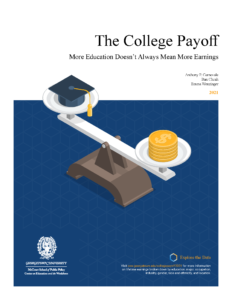
While it is generally true that higher educational attainment correlates with higher earnings, there are many exceptions. As this 2021 report shows in more detail, there are variations based on age, field of study, occupation, gender, race and ethnicity, and geography. As a result, some workers earn less despite having more education, while others earn more despite having less education.
Anthony P. Carnevale, Ban Cheah, and Emma Wenzinger. The College Payoff: More Education Doesn’t Always Mean More Earnings. Washington, DC: Georgetown University Center on Education and the Workforce, 2021.
Retrieved from https://ns4ed.s3.us-east-2.amazonaws.com/ccr/college_payoff_2021-fr.pdf
This literature review addresses the significance of social emotional learning in regard to promoting career readiness by addressing the key components, interpersonal, and intrapersonal skills that are critical to possess in order to be successful in the workforce. This manuscript reviews the five SEL core competencies, the definition and importance of SEL, SEL learning standards, the SEL intrapersonal and interpersonal skills necessary for career success, guiding principles of SEL, as well as the significance of possessing soft skills in order to augment performance and foster success in the workplace.
Paolini, A. C. (2020). Social Emotional Learning: Key to Career Readiness. Anatolian Journal of Education, 5(1), 125-134.
Retrieved from https://files.eric.ed.gov/fulltext/EJ1249147.pdf
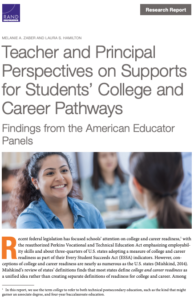 This report provides insight into how high school teachers and principals view how student college and career readiness is supported in their schools. Survey data shows that most schools provide a variety of supports for college and career readiness. However, the results also demonstrate substantial disparities in students’ access to these supports, both between and within schools. Low-income, minority, and low-achieving students have less access to school-based supports than their counterparts within the same schools. This report goes on to detail access to post-secondary information and a geographic analysis of supports.
This report provides insight into how high school teachers and principals view how student college and career readiness is supported in their schools. Survey data shows that most schools provide a variety of supports for college and career readiness. However, the results also demonstrate substantial disparities in students’ access to these supports, both between and within schools. Low-income, minority, and low-achieving students have less access to school-based supports than their counterparts within the same schools. This report goes on to detail access to post-secondary information and a geographic analysis of supports.
Zaber, M. A., & Hamilton, L. S. (2020). Teacher and Principal Perspectives on Supports for Students’ College and Career Pathways (Rep.). Santa Monica, CA: Rand Corporation.
Retrieved from https://www.rand.org/pubs/research_reports/RR4344.html
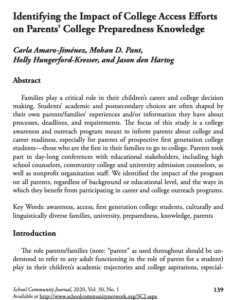 Families play a critical role in their children’s career and college decision making, including knowledge of, and experience with, the processes, deadlines, and requirements. The focus of this study is a college awareness and outreach program meant to inform parents about college and career readiness, especially for parents of prospective first-generation college students–those who are the first in their families to go to college. Parents took part in day-long conferences with educational stakeholders, including high school counselors, community college and university admission counselors, as well as nonprofit organization staff. We identified the impact of the program on all parents, regardless of background or educational level, and the ways in which they benefit from participating in career and college outreach programs.
Families play a critical role in their children’s career and college decision making, including knowledge of, and experience with, the processes, deadlines, and requirements. The focus of this study is a college awareness and outreach program meant to inform parents about college and career readiness, especially for parents of prospective first-generation college students–those who are the first in their families to go to college. Parents took part in day-long conferences with educational stakeholders, including high school counselors, community college and university admission counselors, as well as nonprofit organization staff. We identified the impact of the program on all parents, regardless of background or educational level, and the ways in which they benefit from participating in career and college outreach programs.
Amaro-Jiménez, C., Pant, M. D., Hungerford-Kresser, H., & Den Hartog, J. (2020). Identifying the Impact of College Access Efforts on Parents’ College Preparedness Knowledge. School Community Journal, 30(1), 139-159.
Retrieved from https://files.eric.ed.gov/fulltext/EJ1257633.pdf
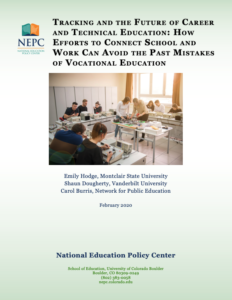 Despite the popularity of Career and Technical Education (CTE), concerns remain about the availability of resources for different CTE pathways, their relative status, and the degree to which adults working within schools are problematically sorting students explicitly or implicitly into different course-taking pathways. This brief explores the question of how schools might meaningfully support career exploration and preparation, while avoiding the tendency of prior vocational education to disproportionately sort students into distinct tracks by ethnic, racial, and/or socioeconomic characteristics. They conclude with recommendations for enacting CTE in ways that support the equitable distribution of educational opportunity.
Despite the popularity of Career and Technical Education (CTE), concerns remain about the availability of resources for different CTE pathways, their relative status, and the degree to which adults working within schools are problematically sorting students explicitly or implicitly into different course-taking pathways. This brief explores the question of how schools might meaningfully support career exploration and preparation, while avoiding the tendency of prior vocational education to disproportionately sort students into distinct tracks by ethnic, racial, and/or socioeconomic characteristics. They conclude with recommendations for enacting CTE in ways that support the equitable distribution of educational opportunity.
Hodge, E., Dougherty, S., & Burris, C. (2020). Tracking and the Future of Career and Technical Education: How Efforts to Connect School and Work Can Avoid the Past Mistakes of Vocational Education (Rep.). Boulder, CO: National Education Policy Center.
Retrieved from https://files.eric.ed.gov/fulltext/ED605784.pdf
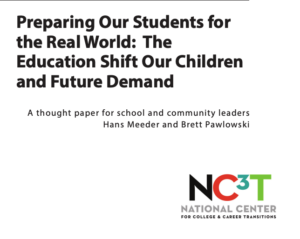 With Career Connected Learning, students are exposed to some aspect of the world of work during the learning process. It might be as a bridge to academic content, such as teaching math skills using examples from the construction industry
With Career Connected Learning, students are exposed to some aspect of the world of work during the learning process. It might be as a bridge to academic content, such as teaching math skills using examples from the construction industry
It is also important to state what it is not: Specifically, it is not work training. Students participating in Career Connected Learning are more likely to pursue – and complete – a postsecondary education. Though of course, it does allow them to be exposed to different roles and industries, giving them a chance to find and pursue opportunities that line up with their strengths and passions.
Meeder, H., & Pawlowski, B. (2020). Preparing Our Students for the Real World: The Education Shift Our Children and Future Demand. Columbia , MD: National Center for College and Career Transitions.
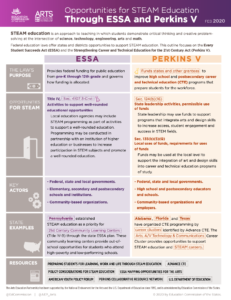 This one-page Policy Outline provides a brief overview of ways in which states and districts can use ESSA and Perkins V funds to support STEAM education.
This one-page Policy Outline provides a brief overview of ways in which states and districts can use ESSA and Perkins V funds to support STEAM education.
Dell’Erba, M. (2020). Opportunities for Steam Education Through Essa and Perkins V. Denver, CO: Education Commission of the United States.
More than half of educators—51 percent—say updating curriculum to get students ready for the jobs of the future is a top priority, according to a poll by the Education Week Research Center. The challenge is figuring out what schools ought to teach. Is it creativity? Data science? Soft skills? In this special report, Education Week tries to fill in some of those blanks. Read on to find out what companies want from new employees, how teachers are infusing “big data” skills into math lessons, and what schools are doing to expose students to cutting-edge business operations. Are your students ready for tomorrow’s workplace?
Montgomery, S. (Ed.). (2020). The New World of Work: Are Schools Falling Behind? [Special Report]. Education Week, 39 (20)
Retrieved from: https://www.edweek.org/ew/collections/new-world-of-work/index.html?cmp=eml-eb-sr-work-02052020&M=59035083&U=1801654&UUID=1b5c725d95c9e10d57f4e7fe39db7cc6 (Complete special report available from Education Week.)
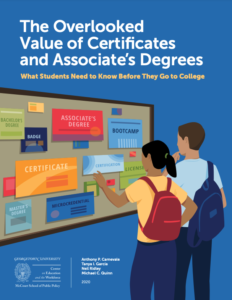 The new rules of the college and career game confirm that education level matters, and that more education is generally better when it comes to earnings potential. What is less well known is that program of study and major matter even more to potential earnings than education level. As a result, less education can often be worth more. Certificates and associate’s degrees—credentials on the middle-skills pathway—can be viable routes to economic opportunity.
The new rules of the college and career game confirm that education level matters, and that more education is generally better when it comes to earnings potential. What is less well known is that program of study and major matter even more to potential earnings than education level. As a result, less education can often be worth more. Certificates and associate’s degrees—credentials on the middle-skills pathway—can be viable routes to economic opportunity.
Carnivale, A. P., Garcia, T. I., Ridley, N., & Quinn, M. C. (2020). The Overlooked Value of Certificates and Associate’s Degrees: What Students Need to Know Before They Go to College. Washington, D.C.: Georgetown University Center on Education and the Workforce.
Retrieved from https://1gyhoq479ufd3yna29x7ubjn-wpengine.netdna-ssl.com/wp-content/uploads/CEW-SubBA.pdf
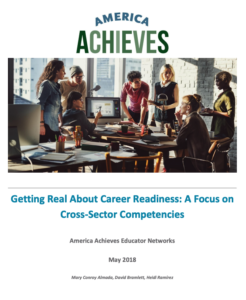 This paper shares learnings from the Global Learning Network 2017 Convening of World-Leading Learners, hosted by America Achieves, in partnership with the Organisation for Economic Co-operation and Development (OECD). Leaders from 30 countries reflected on the changing nature of the economy and job sectors and the impact on education in the 21st century. This paper explores what it means to be career-ready, how schools can develop students’ competencies for success across industry sectors and the important first steps in this process.
This paper shares learnings from the Global Learning Network 2017 Convening of World-Leading Learners, hosted by America Achieves, in partnership with the Organisation for Economic Co-operation and Development (OECD). Leaders from 30 countries reflected on the changing nature of the economy and job sectors and the impact on education in the 21st century. This paper explores what it means to be career-ready, how schools can develop students’ competencies for success across industry sectors and the important first steps in this process.
Almada, M. C., Bramblett, D., & Ramirez, H. (2018). Getting Real About Career Readiness: A Focus on Cross-Sector Competencies (Rep.). New York, NY: America Achieves Educator Networks.
Retrieved from https://files.eric.ed.gov/fulltext/ED596346.pdf
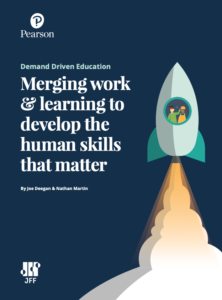 This report concludes that we are on the cusp of a new wave of postsecondary education reform. The first wave focused on access — getting more people to enter higher education. The second wave focused on improving academic success — getting more students to earn certificates and degrees. These waves served as the traditional highways to employment. Now marks the transition to a third wave — which we call “demand driven education” — where programs focus more strongly than ever on ensuring graduates are job-ready and have access to rewarding careers over the course of their lifetimes. Demand-driven education adapts to the needs of the learner and the employer. It responds to signals from society to ensure alignment between desired qualifications and available training.
This report concludes that we are on the cusp of a new wave of postsecondary education reform. The first wave focused on access — getting more people to enter higher education. The second wave focused on improving academic success — getting more students to earn certificates and degrees. These waves served as the traditional highways to employment. Now marks the transition to a third wave — which we call “demand driven education” — where programs focus more strongly than ever on ensuring graduates are job-ready and have access to rewarding careers over the course of their lifetimes. Demand-driven education adapts to the needs of the learner and the employer. It responds to signals from society to ensure alignment between desired qualifications and available training.
Deegan, J., & Martin, N. (2018). Demand-Driven Education: Merging Work & Learning to Develop the Human skills That Matter (Rep.). London, UK: Pearson (in conjunction with Jobs for the Future).
Retrieved from https://www.pearson.com/content/dam/one-dot-com/one-dot-com/global/Files/about-pearson/innovation/open-ideas/DDE_Pearson_Report_3.pdf
This website provides interactive visualizations of pathways data and benchmarks for the sixteen career clusters.
ACT. (2018). Career Pathway Readiness.
Retrieved from https://public.tableau.com/profile/act2044#!/vizhome/CareerReadinessBenchmarks/CareerReadiness
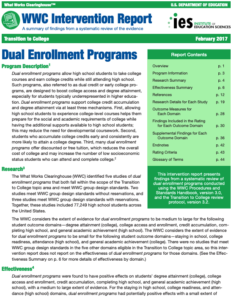 Dual enrollment programs were found to have positive effects on students’ degree attainment (college), college access and enrollment, credit accumulation, completing high school, and general academic achievement (high school), with a medium to large extent of evidence. This is a summary of findings from a systematic review of the evidence as reported in this What Works Clearinghouse Intervention Report.
Dual enrollment programs were found to have positive effects on students’ degree attainment (college), college access and enrollment, credit accumulation, completing high school, and general academic achievement (high school), with a medium to large extent of evidence. This is a summary of findings from a systematic review of the evidence as reported in this What Works Clearinghouse Intervention Report.
Development Services Group, Inc. (2017). Dual Enrollment Programs: Transition to College. Washington, DC: Institute of Education Sciences.
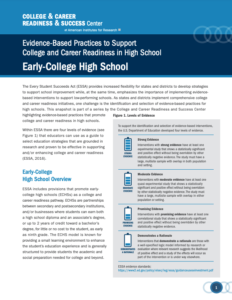 The College and Career Readiness and Success Center highlights evidence-based practices that promote college and career readiness in high schools. This brief focuses on early college high schools which are partnerships between secondary and postsecondary institutions and businesses that allow students to earn both a high-school diploma and an associate’s degree or postsecondary credit towards a bachelor’s degree. This evidence-based practice provides a learning environment that enhances students’ education experience and improves student outcomes in high school and postsecondary education.
The College and Career Readiness and Success Center highlights evidence-based practices that promote college and career readiness in high schools. This brief focuses on early college high schools which are partnerships between secondary and postsecondary institutions and businesses that allow students to earn both a high-school diploma and an associate’s degree or postsecondary credit towards a bachelor’s degree. This evidence-based practice provides a learning environment that enhances students’ education experience and improves student outcomes in high school and postsecondary education.
College & Career Readiness & Success Center at American Institutes for Research. (2017). Evidence-Based Practices to Support College and Career Readiness in High School: Early-College High School. Washington, DC.
Retrieved from https://files.eric.ed.gov/fulltext/ED586413.pdf
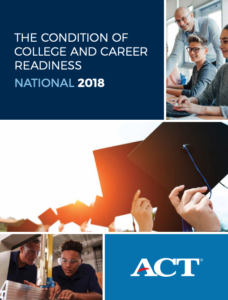 This report looks at the progress of the ACT®-tested 2018 U.S. high school graduating class relative to college and career readiness. The data in this report are based on more than 1.9 million graduates–55% of the students in the 2018 national graduating class–who took the ACT at some time from grade 10 to 12. ACT score data over the years have consistently shown that educational outcomes among U.S. high school graduates–in the form of academic readiness for college and career–are stagnant, and this year’s results suggest they may even be going downhill. Policymakers and educators must take strong, swift actions to reverse this course. The goal should be for all young people to have access to a high-quality, holistic education that will get them on target for college and career readiness by the time they graduate from high school. This report provides recommendations to help meet this goal.
This report looks at the progress of the ACT®-tested 2018 U.S. high school graduating class relative to college and career readiness. The data in this report are based on more than 1.9 million graduates–55% of the students in the 2018 national graduating class–who took the ACT at some time from grade 10 to 12. ACT score data over the years have consistently shown that educational outcomes among U.S. high school graduates–in the form of academic readiness for college and career–are stagnant, and this year’s results suggest they may even be going downhill. Policymakers and educators must take strong, swift actions to reverse this course. The goal should be for all young people to have access to a high-quality, holistic education that will get them on target for college and career readiness by the time they graduate from high school. This report provides recommendations to help meet this goal.
ACT, Inc. (2018). The Condition of College & Career Readiness 2018: National. Iowa City, IA.
Retrieved from https://files.eric.ed.gov/fulltext/ED591977.pdf
States often use summative assessments as a measure to determine students’ readiness for college and career tracks. However, a summative assessment may not always be the best method of measuring students’ college and career readiness. Due to differences in learning needs, or differences in state definitions of college and career readiness, students may require alternative methods of properly and accurately demonstrating this knowledge and these skills. Three examples of these alternatives are utilizing local assessments, utilizing performance-based assessments (such as a portfolio), or offering dual enrollment programs. This brief discusses each of these three examples.
Center on Standards and Assessments Implementation. (2018). Selected Alternatives for Assessing College and Career Readiness. CSAI Update. San Francisco, CA.
Retrieved from https://files.eric.ed.gov/fulltext/ED588469.pdf
The transition from high school to adulthood is challenging for many students, but particularly for students who hold membership in marginalized populations. College and career readiness (CCR) supports can help these students find postsecondary success in a variety of areas, including employment, independent living, postsecondary education, leisure/social activities, and self-advocacy. CCR-focused consultation in the schools is a natural vehicle for improving transition planning, intervention implementation, and professional collaborations. This theme issue showcases partnerships and provides resources for practitioners, educators, and decision makers.
Raines, T. C. (2019). College and Career Readiness Consultation for High-Risk Youth: An Introduction. Journal of Educational and Psychological Consultation, 29(3), 255–259.
Retrieved from https://www.tandfonline.com/doi/full/10.1080/10474412.2019.1565540
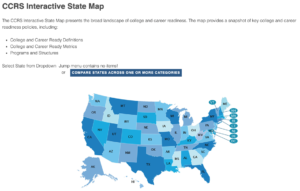 This interactive web-based tool profiles CCR initiatives in each state. Housed on the CCRS Center’s website, each state’s map includes CCR policies, definitions, metrics, programs, and structures. The tool allows policymakers, researchers, and other stakeholders to access and evaluate policies and practices in a single state or compare multiple states across selected categories. Users can access a compiled list of additional resources on related topics by clicking on the Hot Topics link that is available on each state page.
This interactive web-based tool profiles CCR initiatives in each state. Housed on the CCRS Center’s website, each state’s map includes CCR policies, definitions, metrics, programs, and structures. The tool allows policymakers, researchers, and other stakeholders to access and evaluate policies and practices in a single state or compare multiple states across selected categories. Users can access a compiled list of additional resources on related topics by clicking on the Hot Topics link that is available on each state page.
College and Career Readiness and Success Center at American Institutes for Research (2019). CCRS Interactive State Map.
Retrieved from https://ccrscenter.org/ccrs-landscape/state-profile
 Early College High Schools (ECHSs) and dual-enrollment programs allow students to take college courses while still in high school. Research has shown that students participating in these programs are more likely to enroll in college, post higher college grade point averages, persist, and ultimately graduate from college. This report recommends that Congress consider a pilot program that would allow high school students to use federal Pell Grants to pay for college courses.
Early College High Schools (ECHSs) and dual-enrollment programs allow students to take college courses while still in high school. Research has shown that students participating in these programs are more likely to enroll in college, post higher college grade point averages, persist, and ultimately graduate from college. This report recommends that Congress consider a pilot program that would allow high school students to use federal Pell Grants to pay for college courses.
John Hopkins Institute for Education Policy. (2018). Now’s the Time: Early College and Dual-Enrollment Programs in the Higher Education Act. Washington, DC: Alliance for Excellent Education.
Additional Research References
- Anderson, K., & Mire, M. E. (2016, May). Professional Learning: Trends in State Efforts. Benchmarking State Implementation of College- and Career-Readiness Standards. Retrieved from https://www.sreb.org/benchmarking-readiness-standards
- Bottoms, G. (1998). (rep.). State Leadership in Improving High Schools for More Students. Atlanta, GA: Southern Regional Education Board. Retrieved from https://www.sreb.org/sites/main/files/file-attachments/00v01_stateleadership1.pdf?1459729003
- Center on Standards and Assessments Implementation. (2016). High School Graduation Requirements in a Time of College and Career Readiness. Retrieved from https://files.eric.ed.gov/fulltext/ED570363.pdf
- Darling-Hammond, L., Wilhoit, G., & Pittenger, L. (2014). Accountability for College and Career Readiness: Developing a New Paradigm. Education Policy Analysis Archives, 22(86). Retrieved from http://eric.ed.gov/?id=EJ1050070
- Infographic (2014). College and Career Readiness and Success. Chicago, IL Retrieved from https://ies.ed.gov/ncee/edlabs/infographics/pdf/REL_MW_Career_and_College_Readiness_and_Success.pdf
- Dymnicki, A., Sambolt, M., & Kidron, Y. (2013). Improving College and Career Readiness by Incorporating Social and Emotional Learning. College and Career Readiness and Success Center. Retrieved from http://eric.ed.gov/?id=ED555695
- Radcliffe, R. A., & Bos, B. (2013). Strategies to Prepare Middle School and High School Students for College and Career Readiness. The Clearing House: A Journal of Educational Strategies, Issues and Ideas, 86(4), 136–141. https://doi.org/10.1080/00098655.2013.782850
- Schaefer, M. B., & Rivera, L. M. (2012). College and Career Readiness in the Middle Grades. Middle Grades Research Journal, 7(3), 51–66. Retrieved from http://search.proquest.com/openview/cb3272f2e0c79124ca959fcab0962b4f/1?pq-origsite=gscholar
- Hughes, J., & Petscher, Y. (2016). A guide to developing and evaluating a college readiness screener (REL 2016–169). Washington, DC: U.S. Department of Education, Institute of Education Sciences, National Center for Education Evaluation and Regional Assistance, Regional Educational Laboratory Southeast. Retrieved from http://ies.ed.gov/ncee/edlabs.
- Klein, S, & Foster, L. (2015). A Tool for Sustaining Career Pathways Efforts. Retrieved from https://ns4ed.s3.us-east-2.amazonaws.com/ccr/sustainability-draft-03-revised-0729153_final_01.13.16_508compliant.pdf
- Solberg, V, Wills, J. (2014). Use of Individualized Learning Plans: A Promising Practice for Driving College & Career Readiness Efforts. Retrieved from https://ns4ed.s3.us-east-2.amazonaws.com/ccr/ilps-a-promising-practice-for-driving-college-and-career-efforts.pdf
- Beshear, S. (2015). Credentials for All: An Imperative for SREB States. Retrieved from https://ns4ed.s3.us-east-2.amazonaws.com/ccr/cct_report-1.pdf
- College and Career Readiness(CCR) Student Survey. (2011). Retrieved from https://ns4ed.s3.us-east-2.amazonaws.com/ccr/ccr_spring_2011_student_survey-1.pdf
- Orban, J, Mueller, C. (2015) Survey Summary: Career Readiness Assessment a Viable
Option for High School Students. Retrieved from https://www.sreb.org/sites/main/files/file-attachments/cct_report.pdf?1494459159 - SREB STEM-Based Advanced Career(AC) Pathways Prepare Students for Both College & Career. (2016). Retrieved from https://www.sreb.org/sites/main/files/file-attachments/16v02r_ac_brochure_1_24_18_final.pdf?1572965052
- Career & Technical Education, Postsecondary Enrollment & Attainment. (2016). Retrieved from https://nces.ed.gov/pubs2016/2016109.pdf
- Vander Ark, T., & Ryerse, M. (2016). (rep.). Next Generation Career Pathways: A Manufacturing Case Study. Bethesda, MD: Education Week. Retrieved from https://www.edweek.org/teaching-learning/opinion-next-generation-career-pathways-a-manufacturing-case-study/2016/01